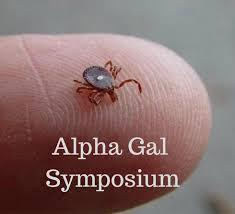Alpha-Gal Syndrome Info
During the summer, our chances of tick interactions increase. Most tick bites are an itchy nuisance that last between seven to 10 days, but ticks can also transmit diseases such as Lyme disease and erlichiosis, a bacterial disease. A relatively new tick-borne illnesses that is increasingly attracting attention is Alpha-gal syndrome.
Known as the “red meat allergy,” alpha-gal syndrome was discovered by medical researchers in 2009 to be a reaction in humans from lone star tick bites. Scientists found the saliva the tick injects as it feeds causes individuals to develop a reaction to galactose-alpha-1,3-galactose, a sugar found in mammalian meats. Alpha-gal is a rare disease but is increasingly becoming more common.
Individuals who have alpha-gal syndrome can have reactions similar to individuals with other food allergies with symptoms that include skin irritations, hives, digestive tract issues and breathing problems. But unlike the typical person with a food allergy, a person with alpha-gal syndrome may have a delayed allergic reaction, anywhere between three and six hours after ingesting mammalian meat or its by-products.
Medical professionals can diagnose alpha-gal through a blood test. Individuals who are diagnosed with the disease must refrain from consuming beef, pork, lamb and venison. Fortunately, they can still eat all fruits, vegetables, grains, nuts, legumes, poultry and seafood. Some people may also have reactions to mammal-derived products including milk, cheese, gelatin and lard. As a result, they and their family members must check ingredient labels before consuming prepackaged food. As individuals with alpha-gal tend to have different tolerance levels to these meat-derived products, individuals should work with a health care provider, such as a registered dietitian, to find a diet that works for them.
Education and prevention are key in reducing your exposure to ticks and any tick-borne diseases. The lone star tick is found throughout Kentucky and the eastern United States, most likely in or near wooded areas. The tick, which gets its name from the iconic white spot found on the female’s back, needs three blood meals for survival during its lifetime. It is most active during April through August.
There are several effective precautions to take to lower your chances of getting a tick bite. Wear a repellent. One repellent containing permethrin can be put on clothing and is particularly effective. Avoid walking through uncut fields or brush and areas with tall vegetation where ticks are most likely to occur. Wear light-colored clothing so ticks are easy to spot. If you are spending a significant amount of time hiking or pursuing other outdoor activities in a tick-prone area, check yourself, your children and other family members for ticks when returning home. Check pets when they come in from outdoors. Common places that you will find ticks are behind ears, hair, neck, legs and around the waist.
If you find a tick on your body, remove it by using fine-tipped tweezers, getting as close to the skin as possible to make sure the entire tick is removed. Once it’s removed, you should wash the bite area and your hands and apply an antiseptic to the bite site.
Additional information is available in UK’s publication ENTFACT-618: Ticks and Disease in Kentucky. It is available online at https://entomology.ca.uky.edu/ef618 or by contacting the Butler Cooperative Extension Service at 270-526-3767.
Educational programs of Kentucky Cooperative Extension serve all people regardless of economic or social status and will not discriminate on the basis of race, color, ethnic origin, national origin, creed, religion, political belief, sex, sexual orientation, gender identity, gender expression, pregnancy, marital status, genetic information, age, veteran status, or physical or mental disability.
By: Tracy M. Cowles, Extension Agent for Family and Consumer Sciences
Source: Jonathan Larson, UK Extension entomologist, Heather Norman-Burgdolf, Extension specialist in food and nutrition



























